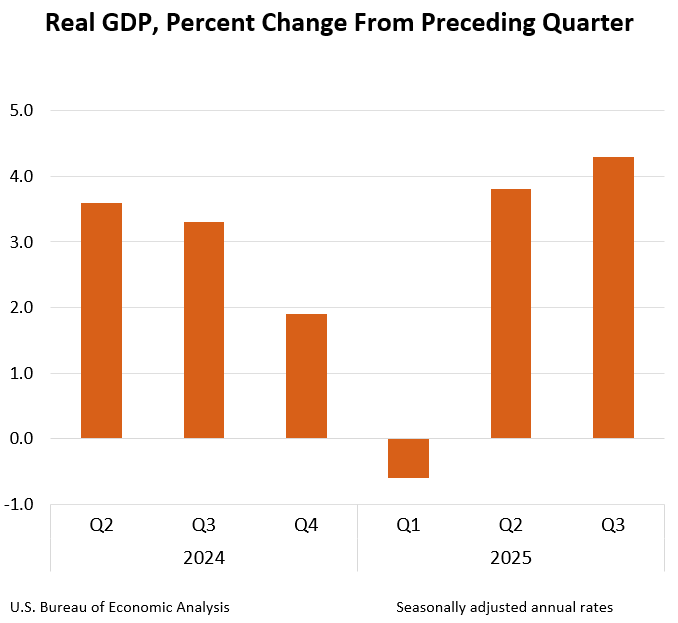Bureau of Economic Analysis
Gross Domestic Product, 3rd Quarter 2025 (Initial Estimate) and Corporate Profits (Preliminary)
Real gross domestic product (GDP) increased at an annual rate of 4.3 percent in the third quarter of 2025 (July, August, and September), according to the initial estimate released by the U.S. Bureau of Economic Analysis. In the second quarter, real GDP increased 3.8 percent. The increase in real GDP in the third quarter reflected increases in consumer spending, exports, and government spending that were partly offset by a decrease in investment. Imports, which are a subtraction in the calculation of GDP, decreased.
Principal Federal Economic Indicators
Noteworthy
The Latest
Direct Investment by Country and Industry, 2022
The U.S. direct investment abroad position, or cumulative level of investment, increased $212.2 billion to $6.58 trillion at the end of 2022 from $6.37 trillion at the end of 2021, according to statistics released today by the U.S. Bureau of Economic Analysis. The increase reflected a $172.8 billion increase in the position in Europe, primarily in the Netherlands and the United Kingdom. By industry, manufacturing affiliates had the largest…
Direct Investment by Country and Industry, 2022
The U.S. direct investment abroad position, or cumulative level of investment, increased $212.2 billion to $6.58 trillion at the end of 2022 from $6.37 trillion at the end of 2021, according to statistics released today by the U.S. Bureau of Economic Analysis. The increase reflected a $172.8 billion increase in the position in Europe, primarily in the Netherlands and the United Kingdom. By industry, manufacturing affiliates had the largest…
New Foreign Direct Investment in the United States, 2022
Expenditures by foreign direct investors to acquire, establish, or expand U.S. businesses totaled $177.5 billion in 2022, down $185.1 billion from $362.6 billion in 2021.
New Foreign Direct Investment in the United States, 2022
Expenditures by foreign direct investors to acquire, establish, or expand U.S. businesses totaled $177.5 billion in 2022, down $185.1 billion from $362.6 billion in 2021.
May 2023 Trade Gap is $69.0 Billion
The U.S. goods and services trade deficit decreased from $74.4 billion in April (revised) to $69.0 billion in May, as imports decreased more than exports. The goods deficit decreased $4.8 billion to $91.3 billion, and the services surplus increased $0.7 billion to $22.3 billion
U.S. International Trade in Goods and Services, May 2023
The U.S. monthly international trade deficit decreased in May 2023 according to the U.S. Bureau of Economic Analysis and the U.S. Census Bureau. The deficit decreased from $74.4 billion in April (revised) to $69.0 billion in May as imports decreased more than exports. The goods deficit decreased $4.8 billion in May to $91.3 billion. The services surplus increased $0.7 billion in May to $22.3 billion.
Gross Domestic Product by State and Personal Income by State, First Quarter 2023
Real gross domestic product increased in all 50 states and the District of Columbia in the first quarter of 2023, with the percent change in real GDP ranging from 12.4 percent in North Dakota to 0.1 percent in Rhode Island and Alabama.
Gross Domestic Product by State and Personal Income by State, 1st Quarter 2023
Real gross domestic product (GDP) increased in all 50 states and the District of Columbia in the first quarter of 2023, with the percent change in real GDP ranging from 12.4 percent in North Dakota to 0.1 percent in Rhode Island and Alabama. Personal income, in current dollars, increased in 48 states and the District of Columbia in the first quarter, with the percent change ranging from 11.4 percent in Maine to –1.0 percent in Indiana.
Personal Income and Outlays, May 2023
Personal income increased $91.2 billion (0.4 percent at a monthly rate) in May. Disposable personal income —personal income less personal current taxes— increased $86.7 billion (0.4 percent). Personal outlays—the sum of personal consumption expenditures, personal interest payments, and personal current transfer payments—increased $22.7 billion (0.1 percent) and consumer spending increased $18.9 billion (0.1 percent). Personal saving was $910.…
Personal Income and Outlays, May 2023
Personal income increased $91.2 billion (0.4 percent at a monthly rate) in May. Disposable personal income (DPI)—personal income less personal current taxes— increased $86.7 billion (0.4 percent). Personal outlays—the sum of personal consumption expenditures, personal interest payments, and personal current transfer payments—increased $22.7 billion (0.1 percent) and consumer spending increased $18.9 billion (0.1 percent). Personal saving was $…




